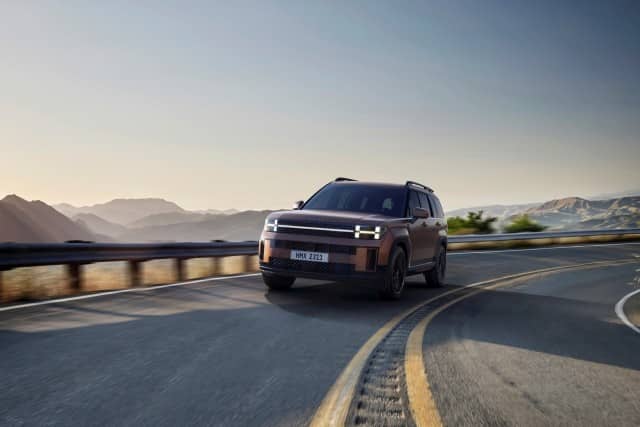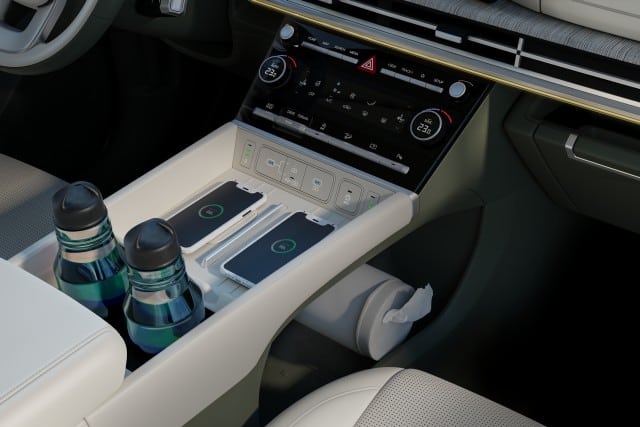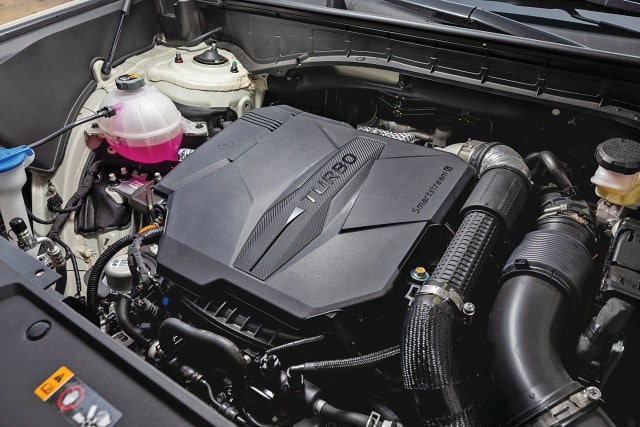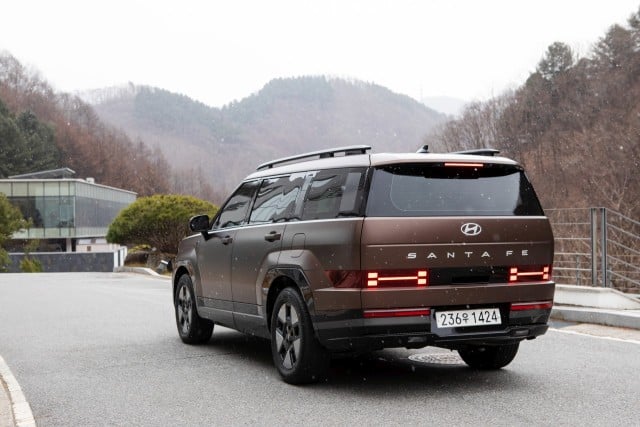
On the move, there is a bit of wheel-spin from the new Hyundai Santa Fe as I prod the accelerator. Keeping to the slow-moving right lane at first, I get comfortable with the proportions easily and then begin to try out the various other bits of kit. It has everything, perhaps, even more than what one would find in a premium luxury SUV costing eight figures here in India. There are heated/cooled seats and a full suite of electronic driver assistants. As we hit the highway, with speed cameras more plentiful than birds in the sky, I engage the smart cruise control, set the speed to 100 km/h, set the vehicle distance to a comfortable amount, then the lane-departure and lane-keep assist. The blind-spot monitor seems to be always on. Not a bad thing. Now, these ADAS features help me spare attention and absorb the many other details. The Santa Fe also has wireless charging with not one, but two bays, plus UV treatment, and storage beneath that, thanks to the by-wire shift-lever on the steering column below the Range Rover-like steering wheel and most controls further up on the console or in the touchscreen. Brilliant!

Hyundai seem to have gotten the ball rolling well over 10 years ago, if you ask me, with the first Grand i10. The focus on bettering essential aspects—quality, feel, handling, and advancing their powertrains—certainly took off. The new Hyundai Santa Fe offers a selection of powertrains wherever one is in the world. These include a pair of electrified “Gamma III” four-cylinder turbo-petrol 1.6s, a 180-hp hybrid and a 160-hp plug-in hybrid electric vehicle (PHEV), and a pair of “Theta III” 2.5-litre petrol fours, one an atmospheric engine with 194 hp and the other, the one that we have here, the 2.5 T-GDI turbo-petrol with 281 hp and a hefty 422 Nm. There could also be the “R” series 2.0-litre turbo-diesel we see in the Tucson on offer, with 186 hp and 416 Nm; the one that could make it to India, may-haps.

The Smartstream G2.5T Theta-III T-GDI engine packs a wallop, but this is a rather compact motor. With long-stroke dimensions of 88.5-mm bore and 101.5-mm stroke, the displacement is 2,497 cc and the peak 281 hp comes in at 6,000 rpm—which explains the note when pushed—with the 422 Nm (or 43 kg-m in Hyundai speak) peaking at just 1,750 rpm but staying flat and strong until 4,000 rpm. The transmission is the 8DCT or eight-speed dual-clutch automatic that drives the front wheels only; sufficient to meet most needs with a nice weight distribution that is evident in most scenarios. In fact, this 2.5T does the 0-100 km/h dash in eight seconds flat and gets up to 210 km/h.
The ride quality is sublime. The suspension has been mildly updated, joined by a more rigid chassis and revised dampers. The handling is commendable and its easy-going and predictable nature makes me not want to stamp down on the throttle but rather just settle in comfortably and enjoy the drive. I could live with this. And then it got even better.
Heading to the cold northern Gangwon State region that is home to the Lee Sang Won art museum and hotel, the air kept getting colder and colder until flecks of ice began to pepper the windscreen and quickly melt into droplets as I took in the breathtakingly beautiful scenery. This was even more enjoyable knowing the safety suite had my back, as I felt the steering wheel nudge my hand further into a turn I had underestimated. The behaviour of the new Hyundai Santa Fe is commendable. Yes, it’s a 2.2-tonne SUV but it drives like a big hatch, much like the Ioniq 5. It’s weird how there seems to be a connection with what seems like a different world. Not once was there a slip or a hint of slide on what had become a visible white accumulation of snow on the road. The Santa Fe held its own like it was driving down a black strip of warm tarmac in its namesake city in New Mexico. It was hard to fault, really. Okay, the Ford Flex brick design and tail-lamps down-low took some time for me to come to terms with, but, tangibly, nothing. It is a well-sorted car.
Justification for my praise, then, is this. It’s not just the features or the styling or the amount of kit in there. It is because of the integrity of the creation. Everything works as it should, in perfect harmony with everything else. The end result is a pleasant, comfortable, and reassuring feel that is beyond the sum of its parts. And that makes it a winner in my book. If only there was a diesel plug-in hybrid that Hyundai developed and brought here!

Need to Know – Hyundai Santa Fe 2.5 T-GDI DCT
Price: Rs 55-60 lakh (estimated)
Engine: 2,497 cc, in-line four, turbo-petrol, direct-injection
Max Power: 281 hp @ 6,000 rpm
Max Torque: 422 Nm @ 1,750-4,000 rpm
Transmission: Eight-speed, dual-clutch automatic, front-wheel drive
Suspension: MacPherson strut front, multi-link rear
Weight: 2,155 kg




















Leave a Reply